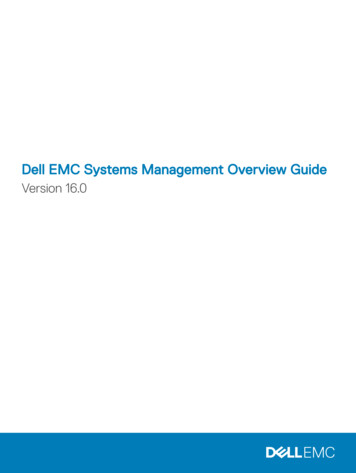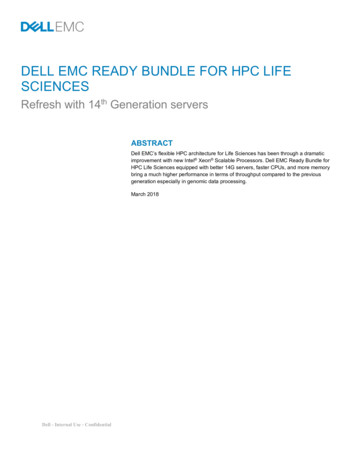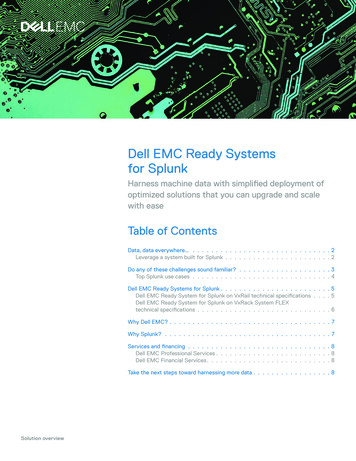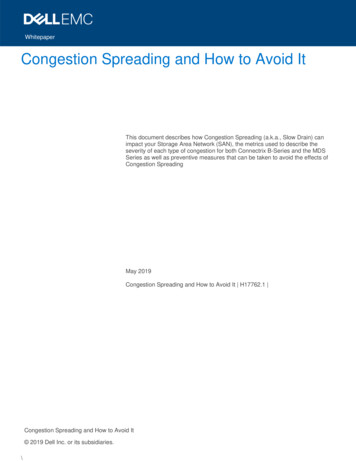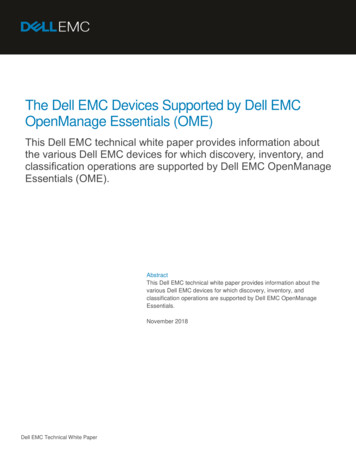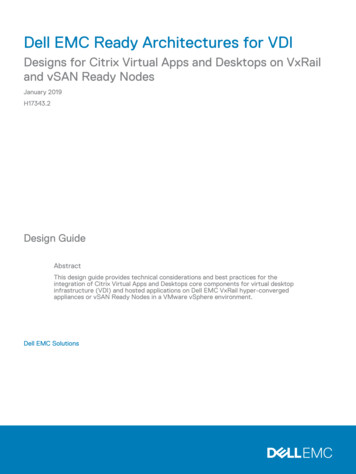
Transcription
Dell EMC Ready Architectures for VDIDesigns for Citrix Virtual Apps and Desktops on VxRailand vSAN Ready NodesJanuary 2019H17343.2Design GuideAbstractThis design guide provides technical considerations and best practices for theintegration of Citrix Virtual Apps and Desktops core components for virtual desktopinfrastructure (VDI) and hosted applications on Dell EMC VxRail hyper-convergedappliances or vSAN Ready Nodes in a VMware vSphere environment.Dell EMC Solutions
Copyright 2018-2019 Dell Inc. or its subsidiaries. All rights reserved.Published January 2019Dell believes the information in this publication is accurate as of its publication date. The information is subject to change without notice.THE INFORMATION IN THIS PUBLICATION IS PROVIDED “AS-IS.“ DELL MAKES NO REPRESENTATIONS OR WARRANTIES OF ANY KIND WITHRESPECT TO THE INFORMATION IN THIS PUBLICATION, AND SPECIFICALLY DISCLAIMS IMPLIED WARRANTIES OF MERCHANTABILITY OR FITNESSFOR A PARTICULAR PURPOSE. USE, COPYING, AND DISTRIBUTION OF ANY DELL SOFTWARE DESCRIBED IN THIS PUBLICATION REQUIRES ANAPPLICABLE SOFTWARE LICENSE.Dell, EMC, and other trademarks are trademarks of Dell Inc. or its subsidiaries. Other trademarks may be the property of their respective owners. Publishedin the USA.Dell EMCHopkinton, Massachusetts 01748-91031-508-435-1000 In North America 1-866-464-7381www.DellEMC.com2Dell EMC Ready Architectures for VDI
ContentslllllllExecutive summary. 4Solution architecture.7Key components. 10Design sizing and guidelines. 17Design enhancements. 20Conclusion. 22References.233
Executive summaryBusiness challengeIn the past, moving from traditional PCs to a virtual desktop infrastructure (VDI)solution was challenging. A classic VDI implementation of 100 applications and 1,000users could take 250 days or more, and the final cost was often unpredictable.Organizations today require end-to-end desktop and application virtualizationinfrastructure solutions that are flexible, reliable, scalable, and easy to deploy.Desktop virtualization helps improve service delivery and competitiveness bysimplifying how IT works on systems, dramatically reducing the complexity of thesystem and making it more flexible. The IT team can then move from being a largelyreactive technical group to playing a proactive role in the strategic organization. DellEMC can assist IT teams in this journey while improving user experience with the DellEMC Ready Architectures for VDI.Some challenges that organizations face today include:4lWorkforce empowerment— Personal technology is driving newer and higherexpectations. People want the same benefits at work as they have on theirpersonal devices. They want faster, easier-to-use devices and applications that fittheir specific needs. Technology itself has become a way to attract and retain thebest talent. It has become a differentiator and a job perk.lOptimized IT resources—Organizations that manage a large number oftraditional PCs find that the task is becoming increasingly complex. With desktopvirtualization, you move applications, data, and the OS (the desktop) to the datacenter. IT can centrally manage the virtual desktop from the data center and savetime and money by troubleshooting PCs remotely instead of physically visitingeach PC.lImproved security—Organizations require the ability to control data, recoverfrom disasters, apply policies, comply with regulations, and monitor risk.Maintaining data and application security, as well as compliance, are the leading ITconcerns in organizations of all sizes. Mobile office trends and bring-your-owndevice initiatives mean that more devices and sensitive data are out of direct ITcontrol, increasing the risk for data theft, viruses, malware, and ransomwareattacks. In addition, traditional antivirus solutions cannot keep up with the amountof new malware that is created daily. Non-security IT specialists also tend to findsecurity and compliance complex.lCost management—Organizations must monitor and optimize the total cost ofownership (TCO), achieve greater utilization from infrastructure assets, andreduce energy use.Dell EMC Ready Architectures for VDI
Technology solutionDell EMC Ready Architectures for VDI on vSAN-based appliances provide a quick andeasy way to simplify and extend your VMware environment. Since ReadyArchitectures for VDI combine compute, storage, virtualization, and management,these solutions are ideal for VDI.The Ready Architectures for VDI are built on industry-leading Dell EMC VxRailappliances or vSAN Ready Nodes appliances. These true hyper-convergedinfrastructure (HCI) platforms provide performance, flexibility, and scale for VDIenvironments.lDell EMC recommends VxRail appliances for an enhanced VDI solution thatleverages a wide range of software, tools, and resources co-developed by DellEMC and VMware. The VMware hyper-converged software is vSphere-ready andbased on vSAN Software-Defined Storage (SDS). The Dell EMC deployment andsupport tools integrate the software management within VxRail Manager. Dataprotection and replication are included and can support either hybrid or all-flashstorage configurations.lDell EMC vSAN Ready Nodes do not include the full automation suite that isavailable in VxRail appliances, but they provide more flexibility in platform choices.vSAN Ready Nodes offer the confidence that your pre-validated configuration willwork with vSAN technology as well as the Citrix Virtual Apps and Desktops suite.Installing Citrix Virtual Apps and Desktops with its VDI components on VxRailappliances or vSAN Ready Nodes enables organizations to quickly deliver MicrosoftWindows virtual desktops or server-based hosted shared sessions on a wide variety ofendpoint devices.Key benefitsDell EMC offers comprehensive, flexible, and efficient VDI solutions that are designedand optimized for your organization's needs. These VDI solutions are easy to plan,easy to deploy, and easy to run.With two different vSAN-based appliance options to choose from, Dell EMC has theideal configuration to start or extend your data center. While VxRail and vSAN ReadyNodes have the same underlying technology (VMware vSAN), each provides uniquebenefits. VxRail offers a turn-key solution to deploying and managing infrastructurewith additional software features to assist throughout the appliance lifecycle. vSANReady Nodes require similar architectural design elements, but do not include thesoftware components and elements that are found in the VxRail product. However,vSAN Ready Nodes offer a greater array of platforms and additional peripheral devicechoices.Dell EMC Ready Architectures for VDI offer several key benefits:lVxRail Manager lifecycle management—The integrated VxRail software lifecyclemanagement keeps software updates and patches current. Updates are easy toinstall and safe to implement, because all software components are engineered,tested, and released as a bundle. Administrators are notified through the VxRailManager when updates are available. Perform updates in your productionenvironment with no downtime while VxRail Manager intelligently deploysimportant updates. VxRail Manager lifecycle management reduces complexity,makes the infrastructure more secure, and removes the risk. (VxRail Manager isavailable only on VxRail.)Technology solution5
lPredictable costs, performance, and scalability to support a growingworkforce—The cost to deploy applications and desktops is dramatically simplerwhen deploying from a data center.lRapid deployments—Ready Architectures for VDI offer rapid automateddeployment. (This feature is a standard offering on VxRail with optional servicesavailable for vSAN Ready Nodes.)lRapid scaling to serve enterprises of any size—Scale rapidly with workloadspecific configurations per platform. The solution is scalable up to 64 nodes percluster, supporting thousands of virtual machines (VMs). Continue scaling withpod architecture and by combining multiple clusters. The VxRail Manager(available only with VxRail appliances) makes it easy to insert or remove nodesfrom your cluster to meet your business needs.lDell EMC support—Dell EMC Ready Architectures for VDI are tested andvalidated Engineering Systems for VDI and its related tools. Deployment Servicesprovide installation of this turn-key VDI appliance to ensure a rapid deploymentwith linear and predictable scalability.Document purposeThis document introduces the architecture, components, design options, bestpractices, and configuration details for successful VDI deployments for VxRailappliances and vSAN Ready Nodes with Citrix Virtual Apps and Desktops.AudienceThis guide is for decision makers, managers, architects, developers, and technicaladministrators of IT environments who want an in-depth understanding of the value ofthe Ready Architectures for VDI that deliver Microsoft Windows virtual desktops tousers using Citrix Virtual Apps and Desktops VDI components on VxRail appliances orvSAN Ready Nodes.We value your feedbackDell EMC and the authors of this document welcome your feedback on the solutionand the solution documentation. Contact the Dell EMC Solutions team by email orprovide your comments by completing our documentation survey.Authors: Dell EMC Ready Architectures for VDI team, Donna RenfroNoteThe following page on the Dell EMC Communities website provides links to additionaldocumentation for VDI Ready Solutions: VDI Info Hub for Ready Solutions.6Dell EMC Ready Architectures for VDI
Solution architectureThis section provides an architecture overview and guidance on managing and scalinga Citrix Virtual Apps and Desktops environment on Dell EMC VxRail appliances.Architecture overviewThe following figure depicts the architecture of the validated solution, including thenetwork, compute, management, and storage layers.Figure 1 VxRail appliances or vSAN Ready Nodes with Citrix Virtual Apps and DesktopsThe deployment option for this Dell EMC Ready System for VDI uses Citrix MachineCreation Services (MCS) with a random or non-persistent desktop—that is, virtualdesktops are assigned randomly as users connect. When users log off, changes theymade are discarded. The desktop is reset to its original state and is available foranother user to log in and use.Solution architecture7
Scaling the solutionvSAN-based appliances solutions provide flexibility as you scale, reducing the initialand future cost of ownership. Add additional physical and virtual servers to the serverpools to scale horizontally. Add virtual resources to the infrastructure to scalevertically.Scaling outEach component of the solution architecture scales independently depending on therequired number of supported users. You can add appliance nodes at any time toexpand the vSAN SDS pool in a modular fashion. The scaling limit for vSAN isrestricted by the limits of the hypervisor at 64 nodes per block.The recommended limit of linked clones per cluster is 4,000.Each instance of VMware vCenter can service a maximum of 4,000 linked or full clonevirtual machines. A Citrix "pod architecture" consists of a virtual desktop "site" andone or more "zones" at each site. The following figure shows a 4,000-user MCS linkedclone/vSAN configuration, which equates to a single zone within a site.Figure 2 Single 4,000-user podThe following figure shows a scale-out of 20,000 MCS linked-clone VMs with vSAN.The recommended limit for a zone is 10,000 sessions. In this example, there are twosites with three zones each. The sites are load-balanced and presented to the users asa single entity.Figure 3 Scaleout for 20,000 users8Dell EMC Ready Architectures for VDI
Scaling upDell EMC recommends a validated disk configuration for general purpose VDI. Theseconfigurations leave drive slots available for future vertical expansion and ensure thatyou protect your investment as new technology transforms your organization.NoteThese configurations can accept additional or faster processors or memory than theguidance provided here.Citrix VDI Handbook and Best Practices provides more information about Citrix bestpractices for scaling.Enterprise solution podsThe compute, management, and storage layers are converged into a single VxRailAppliance or vSAN Ready Nodes block, hosting VMware vSphere. The number ofnodes that are supported for vSphere 6.5 or 6.7, which is 64, determines therecommended boundaries of an individual vSphere cluster.Dell EMC recommends that the VDI management infrastructure nodes be separatedfrom the compute resources. Because our test environment was small, bothmanagement and compute are in the same vSphere HA cluster. Optionally, themanagement node can also be used for VDI VMs with an expected reduction of 30percent of host resources for these nodes only. The 30 percent accounts formanagement VM resource reservations and should be factored in when sizing.Compute hosts can be used interchangeably for Citrix Virtual Apps hosted applicationsand desktops, as required.Enterprise solution pods9
Key componentsThis section describes the key hardware and software components of the solution.VxRail ApplianceThe Dell EMC VxRail is a powerful Hyper-converged Infrastructure Appliance (HCIA)that is available in 1U or 2U rack building blocks. It is built on VMware vSANtechnology and further enabled with Dell EMC software.The following figure shows the components of the VxRail appliance.Figure 4 Dell EMC VxRail applianceVxRail appliance platforms are equipped with Intel Xeon Scalable Processors. You candeploy a cluster with as few as three nodes, providing an ideal environment for smalldeployments. To achieve full vSAN high availability (HA), the recommended startingblock is four nodes. The VxRail Appliance can support storage-heavy workloads withstorage-dense nodes, graphics-heavy VDI workloads with GPU hardware, and entrylevel nodes for remote and branch office environments.The VxRail appliance enables you to start small and scale as your requirementsincrease. Single-node scaling and low-cost entry point options give you the freedom tobuy just the right amount of storage and compute resources to start, and then addcapacity to support growth. A single-node VxRail V Series appliance can be configuredwith 16 to 56 CPU cores per node and support a maximum of 40 TB raw storage with ahybrid configuration of 76 TB with the all-flash option. A 64-node all-flash clusterdelivers a maximum of 3,584 cores and 4,864 TB of raw storage. The following tableshows the available platforms.Table 1 Available Dell EMC VxRail platforms10PlatformDescriptionConfigurationsForm FactorE SeriesEntry levelAll-flash and hybrid1U1NV SeriesVDI optimizedAll-flash and hybrid2U1NP SeriesPerformance optimizedAll-flash and hybrid2U1NS SeriesStorage denseHybrid2U1NDell EMC Ready Architectures for VDI
VxRail ManagerVxRail Manager, which is available on VxRail appliances only, is the primarydeployment and element manager interface of the appliance. VxRail Managersimplifies the entire lifecycle from deployment through management, scaling, andmaintenance. It also enables single-click upgrades and dashboard monitoring forhealth, events, and physical views.vSAN Ready NodesvSAN Ready Nodes are pre-validated Dell EMC Server configurations that reduce thecomplexity of deploying vSAN technology. vSAN Ready Nodes configurations arelisted in the vSAN Ready Node compatibility guide on the VMware website. vSANReady Nodes provide more customized hardware and platforms to meet your datacenter needs.Because vSAN Ready Nodes do not offer lifecycle management and additional bundledsoftware, Dell EMC recommends customized deployment services and at least threeyears of ProSupport Plus. Add Citrix Virtual Apps and Desktops to license your DellEMC vSAN Ready Nodes for a full VDI deployment.Dell EMC Ready Architectures VDI-optimized configurationsFor graphics-intensive desktop deployments, we recommend the VDI-optimized 2U/1Node appliances that support GPU hardware.The VxRail V Series and vSAN Ready Nodes R740XD can be configured with orwithout GPUs. Dell EMC also offers similar configurations in a 1U/1 Node appliance,although graphics configurations are not available on these platforms.We have designated common configurations as A3, B5, and C7. These designations arereferenced throughout the documentation.ConfigurationCPURAMDiskGPU (optional)DescriptionA32x 10-core192 GB(12x 16 GB @ 2400MHz)4 TB (Capacity)Up to 3x full length,dual width (FLDW)Up to 6x full lengthsingle width(FLSW)aFor small-scale, POC, orlow-density, costconscience environmentsB52x 14-core384 GB(12x 32 GB @ 2400MHz)6 TB (Capacity)Up to 3x FLDWUp to 6x full lengthsingle width(FLSW)aGeared toward larger-scalegeneral-purposeworkloads; balancesperformance and costeffectivenessC72x 20-core768 GB(24x 32 GB @ 2667MHz)8 TB (Capacity)Up to 3x FLDWUp to 6x full lengthsingle width(FLSW) aOffers an abundance ofhigh-performance featuresand tiered capacity thatmaximizes user densitya.Only available with vSAN Ready Nodes based on the R740xd platform. NVIDIA Pascal P4 is the only FLSW card available at thistime.vSAN Ready Nodes11
vSAN software-defined storagevSAN is available in hybrid or all-flash configurations.After vSAN is enabled on a cluster, all disk devices presented to the hosts are pooledtogether to create a shared data store that is accessible by all hosts in the VMwarevSAN cluster. VMs can then be created with storage policies assigned to them. Thestorage policy dictates availability, performance, and sizing.vSAN provides the following configuration options:lHybrid configuration—Uses flash-based devices for the cache tier and magneticdisks for the capacity tier. Hybrid configurations are ideal for clients looking forhigher volume in the capacity tier. The performance of SSD and magnetic spinningdisks is comparable in VDI applications.lAll-flash configuration—Uses flash for both the cache tier and capacity tier todeliver enterprise performance and a resilient storage platform. In thisconfiguration, the cache tier is fully dedicated to writes, allowing all reads to comedirectly from the capacity tier. This model allows the cache device to protect theendurance of the capacity tier. All-flash configured solutions enable datadeduplication features to extend the capacity tier.NVIDIA GPUNVIDIA GPU accelerators provide high performance for demanding enterprise datacenter workloads.In applications ranging from energy exploration to deep learning, scientists can nowprocess petabytes of data up to ten times faster than with CPUs. NVIDIA acceleratorsdeliver the horsepower that is required to run large simulations faster than everbefore. For enterprises deploying VDI, NVIDIA accelerators are perfect foraccelerating virtual desktops. GPUs can be used in the V570 or V570F applianceconfigurations or on vSAN Ready Nodes that are built on the PowerEdge R740xdchassis.Physical network componentsReady Architectures for VDI for appliances allow for flexibility in networkingselections. VDI validations have been successfully performed with the followinghardware, although several other choices are available.lDell EMC Networking S3048 (1 GbE ToR switch)—The S3048 switchaccelerates applications in high-performance environments with a low-latencytop-of-rack (ToR) switch that features 48 x 1 GbE and 4 x 10 GbE ports, a dense1U design, and up to 260 Gbps performance. The S3048-ON also supports OpenNetwork Installation Environment (ONIE) for zero-touch installation of alternatenetwork operating systems.lDell EMC Networking S4048 (10 GbE ToR switch)—The S4048 switchoptimizes your network for virtualization with a high-density, ultra-low-latencyToR switch that features 48 x 10 GbE SFP and 6 x 40 GbE ports (or 72 x 10 GbEports in breakout mode) and up to 720 Gbps performance. The S4048-ON alsosupports ONIE for zero-touch installation of alternate network operating systems.Dell EMC Networking S-Series 10GbE switches on the Dell EMC website providesmore information about these switches.12Dell EMC Ready Architectures for VDI
NoteEnsure that you comply with the switch requirements in the VxRail Networking Guide,which provides important information, recommendations, and best practices forVxRail. Consider the same recommendations for vSAN Ready Nodes.NetworkingDesigned for true linear scaling, VxRail appliances use a leaf-spine networkarchitecture, which consists of two network tiers: an L2 Leaf and an L3 Spine that isbased on 40 GbE and non-blocking switches. This architecture maintains consistentperformance without any throughput reduction.VMware vSphereVMware vSphere provides a powerful, flexible, and secure foundation for businessagility that accelerates the digital transformation to cloud computing and promotessuccess in the digital economy.vSphere provides the following benefits for VDI applications:lImproved Appliance Management—The vCenter Server Appliance Managementinterface provides CPU and memory statistics, network and database statistics,disk space usage, and health data. These features reduce reliance on a commandline interface for simple monitoring and operational tasks.lVMware vCenter Server native high availability—This solution for vCenterServer Appliance consists of active, passive, and witness nodes that are clonedfrom the existing vCenter Server instance. The vCenter HA cluster can beenabled, disabled, or destroyed at any time. Maintenance mode prevents plannedmaintenance from causing an unwanted failover. The vCenter Server databaseuses Native PostgreSQL synchronous replication, while key data outside thedatabase uses a separate asynchronous file system replication.lBackup and Restore—Native backup and restore for the vCenter ServerAppliance enables users to back up vCenter Server and Platform ServicesController appliances directly from the VAMI or API. The backup consists of a setof files that is streamed to a selected storage device using SCP, HTTP(S), orFTP(S) protocols. This backup fully supports VCSA instances with both embeddedand external Platform Services Controller instances.lVMware vSphere HA Support for NVIDIA GRID vGPU-configured VMs—vSphere HA protects VMs with the NVIDIA GRID vGPU shared pass-throughdevice. In the event of a failure, vSphere HA tries to restart the VMs on anotherhost that has an identical NVIDIA GRID vGPU profile. If no available healthy hostmeets this criterion, the VM fails to power on.lVMware vSAN Enterprise Edition—Includes all-flash space-efficiency features(deduplication, compression, and erasure coding), software-defined, data-at-restencryption, and stretched clusters for cost-efficient performance and greaterhardware choice.lVMware Log Insight—Provides log management, actionable dashboards, andrefined analytics, which enable deep operational visibility and fastertroubleshooting.VMware vSphere13
NotevSphere Enterprise Edition (or vSphere Desktop) is required to support NVIDIAgraphics cards.Citrix Virtual Apps and DesktopsThe architecture that this guide describes is based on Citrix Virtual Apps andDesktops, which provides a complete end-to-end solution delivering MicrosoftWindows virtual desktops to users on a wide variety of endpoint devices. Virtualdesktops are dynamically assembled on demand, providing users with pristine, yetpersonalized, desktops each time they log in.Citrix Virtual Apps and Desktops provides a complete virtual desktop delivery systemby integrating several distributed components with advanced configuration tools thatsimplify the creation and real-time management of the virtual desktop infrastructure.Figure 5 Citrix Virtual Apps and Desktops architectureThe core Citrix Virtual Apps and Desktops components include:14lStudio—Studio is the management console that enables you to configure andmanage your deployment, eliminating the need for separate management consolesfor managing delivery of applications and desktops. Studio provides variouswizards to guide you through the process of setting up your environment, creatingyour workloads to host applications and desktops, and assigning applications anddesktops to users.lDelivery Controller (DC)—Installed on servers in the data center, the controllerauthenticates users, manages the assembly of users' virtual desktopenvironments, and brokers connections between users and their virtual desktops.DC also manages the state of desktops, starting and stopping them based ondemand and administrative configuration.Dell EMC Ready Architectures for VDI
lDatabase—At least one Microsoft SQL Server database is required for everyvirtual application or desktop Site to store configuration and session information.DC must have a persistent connection to the database as it stores data that iscollected and managed by the Controller services.lDirector—Director is a web-based tool that enables IT support teams to monitoran environment, troubleshoot issues before they become system-critical, andperform support tasks for end users. You can also view and interact with a user'ssessions using Microsoft Remote Assistance. Starting in version 7.12, Director nowincludes detailed descriptions for connection and computer failures, one-monthhistorical data (Enterprise edition), custom reporting, and notifications via SNMPtraps.lReceiver—Installed on user devices, Citrix Receiver provides users with quick,secure, self-service access to documents, applications, and desktops from any ofthe user's devices including smart phones, tablets, and PCs. Receiver provides ondemand access to Windows, web, and Software as a Service (SaaS) applications.For devices that cannot install the Receiver software, Citrix Receiver for HTML5provides connectivity through a HTML5-compatible web browser.lStoreFront—StoreFront authenticates users to sites hosting resources andmanages stores of desktops and applications that users access. StoreFrontversion 3.8 (released with XenDesktop 7.12) and above includes the ability tocreate and use multiple IIS websites each having its own domain name.lLicense Server—The Citrix License Server is an essential component of anyCitrix-based solution. Every Citrix product environment must have at least oneshared or dedicated license server. License servers are computers that are eitherpartly or completely dedicated to storing and managing licenses. Citrix productsrequest licenses from a license server when users try to connect.lMachine Creation Services (MCS)—A collection of services that work togetherto create virtual servers and desktops on demand from a master image, optimizingstorage utilization, and providing a pristine virtual machine to users every timethey log in. Machine Creation Services is fully integrated and administered in CitrixStudio.Figure 6 Machine Creation Services architectureCitrix Virtual Apps and Desktops15
lVirtual Delivery Agent (VDA)—A transparent plugin that is installed on everyvirtual desktop or application host (RDSH). VDA enables the direct connectionbetween the virtual desktop and users' endpoint devices. Windows and Linux VDAsare available.Client componentsEnd users can use a variety of client components to access the virtual desktops.The following table lists the client components that Dell EMC recommends.Table 2 Recommended clientsComponentDescriptionRecommended useMore informationDell Wyse 3040 thin clientDell's lightest, smallest, andmost power-efficient thinclientTask and basic -3040-thinclient/pdDell Wyse 5070 thin clientA single thin client platformthat meets every need, theDell Wyse 5070 has multipleOS and connectivity optionsand can be monitored,maintained, and servicedremotely.Knowledge workers whohttps://need powerful virtual desktop thinclientbenefits.com/performance and support for products/wyse-5070unified communicationssolutions like Skype forBusinessDell Wyse 5070 Extendedthin clientOffers an on-board graphicscard for offloading andsupporting up to four 4Kmonitors plus two 2K monitors(total of 6)Knowledge workers whohttps://need powerful virtual desktop thinclientbenefits.com/performance and support for products/wyse-5070several monitors16Dell EMC Ready Architectures for VDI
Design sizing and guidelinesThis section provides recommendations and guidelines for designing your VDIenvironment.Platform configurationsWith several options to choose from, consider these basic differences.lSelect the base B5 configuration when designing smaller deployments to meetminimum node requirements. B5 configurations scale well and can also effectivelyserve the maximum number of VMs for a block.lC7 configurations are denser configurations that are intended for a higher scaleand to reduce the number of nodes to maintain.NoteIn the event of a node outage, the C7 configuration impacts more users.CPUUser density and graphics considerations:llDell EMC Ready Architectures for VDI validation test results suggest that you canuse CPU oversubscription to effectively size VDI user density. To use a CPUconfiguration other than those that have been validated, consider the followingguidance to achieve comparable results:nTask workers—4.25 users per core. For example, 68 task users with dualeight-core processors.nKnowledge workers—3.75 users per core. For example, 60 knowledge userswith dual eight-core processors.nPower workers—2.75 users per core. For example,
These true hyper-converged infrastructure (HCI) platforms provide performance, flexibility, and scale for VDI environments. l Dell EMC recommends VxRail appliances for an enhanced VDI solution that leverages a wide range of software, tools, and resources co-developed by Dell EMC and VMware. The VMware hyper-converged software is vSphere-ready and




